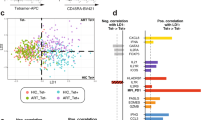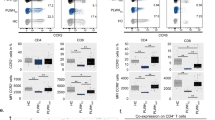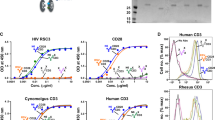Abstract
CXC-chemokine receptor (CXCR)-4/fusin, a newly discovered co-receptor for T-cell line (T)-tropic HIV-1 virus, plays a critical role in T-tropic virus fusion and entry into permissive cells. The occurrence of T-tropic HIV viruses is associated with CD4-positive cell decline and progression to AIDS, suggesting that the T-tropic HIV-1 contributes to AIDS pathogenesis. In this study, we used a novel strategy to inactivate CXCR-4 by targeting a modified CXC-chemokine to the endoplasmic reticulum (ER) to block the surface expression of newly synthesized CXCR-4. The genetically modified lymphocytes expressing this intracellular chemokine, termed “intrakine”, are immune to T-tropic virus infection and appear to retain normal biological features. Thus, this genetic intrakine strategy is uniquely targeted at the conserved cellular receptor for the prevention of HIV-1 entry and may be developed into an effective treatment for HIV-1 infection and AIDS.
This is a preview of subscription content, access via your institution
Access options
Subscribe to this journal
Receive 12 print issues and online access
$209.00 per year
only $17.42 per issue
Buy this article
- Purchase on Springer Link
- Instant access to full article PDF
Prices may be subject to local taxes which are calculated during checkout
Similar content being viewed by others
References
Feng, Y., Broder, C., Kennedy, P.E. & Berger, E.A. HIV-1 entry cofactor: Functional cDNA cloning of a seven-transmembrane C protein-coupled receptor. Science 272, 809–810 (1996).
Bleul, C.C. et al. The lymphocyte chemoattractant SDF-1 is a ligand for LESTR/fusin and blocks HIV-1 entry. Nature 382, 829–833 (1996).
Oberlin, E. et al. The CXC chemokine SDF-1 is the ligand for LESTR/fusin and prevents infection by T-cell-line adapted HIV-1. Nature 382, 833–835 (1996).
Cheng-Mayer, C., Tateno, T., Seto, D. & Levy, J. Biological features of HIV that correlate with virulence in the host. Science 240, 80–82 (1988).
Tersmette, M. et al. Association between biological properties of human immunodeficiency virus variants and risk for AIDS mortality. Lancet i, 983–985 (1989).
Roos, M.T.L. et al. Viral phenotype and immune response in primary human immunodeficiency virus type-1 infection. J. Infect. Dis. 165, 427–432 (1992).
Loetscher, M. T. et al. Cloning of a human seven-transmembrane domain receptor, LESTR, that is highly expressed in leukocytes. J. Biol. Chem. 269, 232–237 (1994).
Baggliolini, M., Dewald, B. & Moser, B. lnterleukin-8 and related chemotactic cy-tokines-CXC and CC chemokines. Adv. Immunol. 55, 97–179 (1994).
Nagasawa, T., Kikutani, H. & Kishimoto, T. Molecular cloning and structure of a pre-B-cell growth stimulating factor. Proc. Natl. Acad. Sci. USA. 491, 2305–2309 (1994).
Shirozu, M. et al. Structure and chromosomal localization of the human stromal cell-derived factor 1 (SDF1) gene. Cenomics 28, 495–500 (1995).
Marasco, W.A., Haseltine, W.A. & Chen, S.-Y., Design, intracellular expression, and activity of a human anti-HIV-1 gpl 20 single chain antibody. Proc. Natl. Acad. Sci. USA 90, 7889–7893 (1993).
Chen, S.-Y., Khouri, Y., Bagley, J. & Marasco, W.A. Combined intra-and extracellular immunization against HIV-1 infection with a human anti-gp 120 antibody. Proc. Natl. Acad. Sci. USA 91, 5932–5936 (1994).
Chen, S.-Y., Bagley, J. & Marasco, W.A. Intercellular antibodies as a new class of therapeutic molecules for gene therapy. Hum. Cene Ther. 5, 595–601 (1994).
Buonocore, L. & Rose, J.K. Blockade of human immunodeficiency virus type 1 production in CD4+ T cells by an intracellular CD4 expressed under control of the viral long terminal repeat. Proc. Natl. Acad. Sci. USA 90, 2695–2699 (1993).
Field, J. et al. Purification of a RAS-responsive adenylyl cyclase complex from Saccharomyces cerevisiae by use of an epitope addition method. Mol. Cell. Biol. 8, 2159–2165 (1988).
Daniel, M.D. et al. Simian immunodeficiency virus from African Green monkeys. J. Virol. 62, 4123–4128 (1988).
Chen, S.-Y. et al. Potent anti-tumor activities of a new class of tumor-specific cytotoxic cells. Nature 385, 78–80 (1997).
Choe, H. et al. The β-chemokine receptors CCR3 and CCR5 facilitate infection by primary HIV-1 isolates. Cell 85, 1135–1148 (1996).
Phillips, K., Gentry, T., McCowage, G., Gilboa, E. & Smith, C. Cell-surface markers for assessing gene transfer into human hematopoietic Cells. Nature Med. 2, 1154–1156 (1996).
Rudoll, T. et al. High-efficiency retroviral vector mediated gene transfer into human peripheral blood CD4+ T lymphocytes. Gene Ther. 3, 695–705 (1996).
Pear, W.S., Nolan, G.P., Scott, M.L. & Baltimore, D. Production of high-liter helper-free retroviruses by transient transfection. Proc Natl. Acad. Sci. USA 90, 8392–8396 (1993).
Pear, W.S., Scott, M.L. & Nolan, G.P. Generation of high-liter, helper-free retroviruses by transienl Iransfection. in Methods in Molecular Biology: Methods In Cene Therapy (ed. Robbins, P.) 41–57 (Humana Press, Totowa, NJ, 1997).
Yu, M., Poeschla, E. & Wong-Staal, F. Progress toward gene therapy for HIV-1 infection. Gene Ther. 1, 13–26 (1994).
Lippincott-Schwartz, J., Bonifacino, J.S., Yuan, L.C. & Klausner, R.D. Degradalion from the endoplasmic reliculum: Disposing of newly synlhesized proleins. Cell 54, 209–220 (1988).
Rose, J.K. & Doms, R.W. Regulation of prolein export from the endoplasmic reticulum. Annu. Rev. Cell Biol. 4, 257–288 (1988).
Fra, A.M., Fagioli, C., Finazzi, D., Sitia, R. & Alberini, C.M. Quality control of ER synthesized proteins: Exposed thio group as a three-way swilch mediating assembly, retention and degradation. EMBO J. 12, 4755–4761 (1993).
Kopito, R.R. ER quality control: The cytoplasmic connection. Cell. 88, 427–430 (1997).
Van Zee, K.J. et al. Effects of intravenous IL-8 administration in nonhuman primates. J Immunol. 148, 1746–1752 (1992).
Deng, H. et al. Identification of a major co-receptor for primary isolates of HIV-1. Nature 381, 661–666 (1996).
Alkhatib, G. et al. CC CCR5: A RANTES, MIP-1α, MIP-1β receptor as a fusion cofactor for macrophage-tropic HIV-1. Science 272, 1955–1958 (1996).
Doranz, B.J. et al. A dual-tropic primary HIV-1 isolate that uses fusin and the CC-chemokine receptors CCR-5, CCR-3, and CCR-2b as fusion cofactors. Cell 85, 1149–1158 (1996).
Dragic, T. et al. HIV-1 entry into CD4 cells is mediated by the chemokine receptor CC-CCR-5. Nature 381, 667–673 (1996).
Nagasawa, T. et al. Defects of B-cell lymphopoiesis and bone-marrow myelopoiesis in mice lacking the CXC chemokine PBSF/SDF-1. Nature 382, 635–638 (1996).
Liu, R. et al. Homozygous defect in HIV-1 co-receptor accounts for resistance of some multiply-exposed individuals to HIV-1 infection. Cell 86, 367–377 (1996).
Samson, M. et al. Resistance to HIV-1 infection in Caucasian individuals bearing mutant alleles of the CCR-5 chemokine receptor gene. Nature 282, 722–725 (1996).
Dean, M. et al. Genetic restriction of HIV-1 infection and progression to AIDS by a deletion allele of the CCR5 structural gene. Science 273, 1856–1862 (1996).
Huang, Y. et al. The role of a mutant CCRi allele in HIV-1 transmission and disease progression. Nature Med. 2, 1240–1243 (1996).
Biti, R., Ffrench, R., Young, J., Bennetts, B., Stewart, G. & Liang, T. HIV-1 infection in an individual homozygous for the CCR5 deletion allele. Nature Med. 3, 252–253 (1997).
Michael, N.L. et al. The role of viral phenotype and CCR-5 gene defects in HIV-1 transmission and disease progression. Nature Med. 3, 338–340 (1997).
Yang, A.-G. & Chen, S.-Y. A new class of antigen-specific cytotoxic cells. Nature Biotechnol. 15, 46–51 (1997).
Chen, J.-D., Yang, Q., Yang, A., Marasco, W. & Chen, S.-Y. Intra-and extracellular immunization against HIV-1 infection with lymphocytes transduced with an anti-gp 120 antibody gene using AAV vectors. Hum. Cene Ther. 7, 1515–1525 (1996).
Endres, M.J. et al. CD4-independent infection by HIV-2 is mediated by fusin/CXCR4. Cell 87, 745–756 (1996).
Yang, A.-G., Bai, X., Huang, X.F., Yao, C. & Chen, S.-Y. Phenotypic knockout of chemokine CCR5 coreceptor by intrakines for HIV-1 therapy. Proc. Natl. Acad. Sci. USA (in the press).
Author information
Authors and Affiliations
Rights and permissions
About this article
Cite this article
Chen, JD., Bai, X., Yang, AG. et al. Inactivation of HIV-1 chemokine co-receptor CXCR-4 by a novel intrakine strategy. Nat Med 3, 1110–1116 (1997). https://doi.org/10.1038/nm1097-1110
Received:
Accepted:
Issue Date:
DOI: https://doi.org/10.1038/nm1097-1110
This article is cited by
-
Synthetic antibody discovery against native antigens by CRISPR/Cas9-library generation and endoplasmic reticulum screening
Applied Microbiology and Biotechnology (2020)
-
Effect of the chemokine receptor CXCR7 on proliferation of carcinoma cells in vitro and in vivo
British Journal of Cancer (2008)
-
CXCR4 knockdown by small interfering RNA abrogates breast tumor growth in vivo
Cancer Gene Therapy (2005)
-
Protecting from R5-tropic HIV: individual and combined effectiveness of a hammerhead ribozyme and a single-chain Fv antibody that targets CCR5
Gene Therapy (2004)
-
Inhibition of HIV-1 fusion with small interfering RNAs targeting the chemokine coreceptor CXCR4
Gene Therapy (2004)



